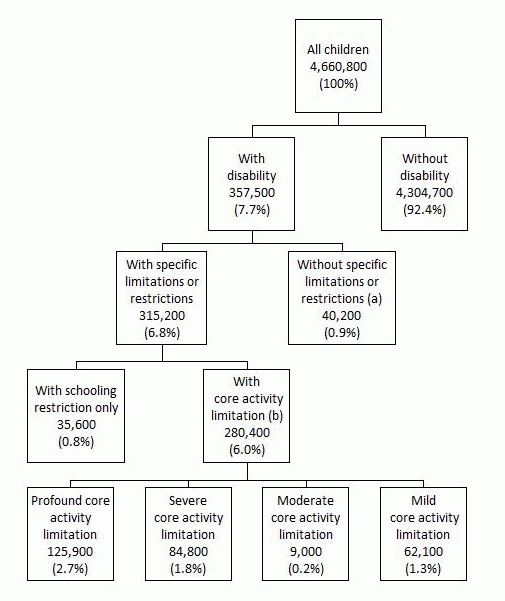Disability
- In 2018 there were 4.4 million Australians with disability, 17.7% of the population, down from 18.3% in 2015.
- The prevalence of disability increased with age - one in nine (11.6%) people aged 0-64 years and one in two (49.6%) people aged 65 years and over had disability.
- Disability prevalence was similar for males (17.6%) and females (17.8%).
- 5.7% of all Australians had a profound or severe disability.
- Almost one-quarter (23.2%) of all people with disability reported a mental or behavioural disorder as their main condition, up from 21.5% in 2015.
Of those with disability (living in households):
- one-third (33.4%) of those aged 15 years and over had completed year 12 or equivalent, up from 31.4% in 2015
- one in six (16.1%) aged 15 years and over had a Bachelor degree or above, up from 14.9% in 2015
- 37.9% of those aged 15-64 years said their main source of personal income was a government pension or allowance, down from 41.9% in 2015
- 59.7% of people had their need for assistance fully met, down from 62.1% in 2015
- one in 10 (9.6%) aged 15 years and over had experienced discrimination in the previous 12 months because of their disability, up from 8.6% in 2015
- labour force participation for those aged 15-64 years has remained stable since 2015 at 53.4%, in contrast to an increase in the participation rate for people without disability (84.1%)
- 11.4% of those with a profound or severe disability (aged 15-64 years) were working full-time up from 7.9% in 2015.
Older people
- One in every six Australians (15.9% or 3.9 million people) was aged 65 years and over (up from 15.1% in 2015).
- Most older Australians (persons aged 65 years and over) were living in households (95.3%), with 4.6% living in cared accommodation.
- Half (49.6%) of all older Australians had disability (similar to 2015).
- 1.3 million older Australians living at home needed some assistance with everyday activities, and of these, almost two-thirds (65.9%) had their need fully met (down from 69.2% in 2015).
- Two-thirds (68.1%) of older Australians (who reported income) lived in a low income household (a household earning less than $756 per week).
- Almost all older Australians had participated in social activities at home (97.4%) or outside their home (94.4%) in the previous three months.
Carers
- There were 2.65 million carers, representing 10.8% of all Australians (down from 11.6% in 2015).
- Females were more likely to be carers (12.3% of all females) than males (9.3% of all males).
- There were 235,300 young carers (under the age of 25), down from 274,700 in 2015.
- 3.5% of all Australians were primary carers.
- Seven in ten (71.8%) primary carers were women.
- Over one-third (37.4%) of primary carers had disability, twice the rate of non-carers (15.3%).
- The most common reason primary carers gave for taking on a caring role was a sense of family responsibility (70.1% of all primary carers).
- Half (50.2%) of all carers lived in a household in the lowest two equivalised gross income quintiles, twice that of non-carers (25.6%).
